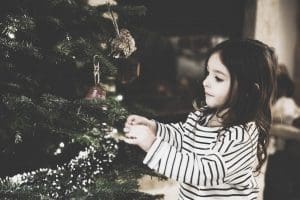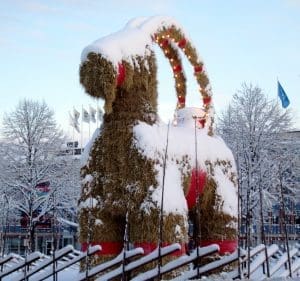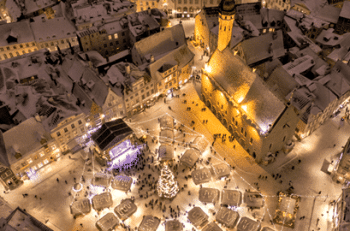Christmas is a time of tradition – but how do people go about celebrating Christmas around the world?
Christmas trees, mince pies, getting silly drunk at the works ‘do’ and watching ‘Elf’ on repeat for the whole of December. These rituals, both silly and sacred, are a comforting, intrinsic part of our lives.

People celebrate Christmas with traditions – such as children dressing the tree.
Quirky family traditions should be cherished too. No-one knows how or why the angel made from a light bulb came to grace the top of the Christmas tree (just us then?!) or why a Chinese takeaway is an absolute must for your Christmas Eve tea. It’s just what has always been done and is what will be repeated ad infinitum.
Christmas is celebrated by countries around the world and each of them has their own unique way of honouring the festival. Some might seem a little odd! Then again, your comfy pyjamas and gin fizz on the sofa-based Christmas day probably appears very weird to the family across the road who go for a 10-mile walk in the country every year. It’s all a matter of taste.
Here’s the Christmas.co.uk round-up of the most interesting international Christmas traditions.
Celebrating Christmas with quirky characters
Iceland
In Iceland, the days before Christmas are the playtime of 13 mischievous characters. Each night belongs to one of these cheeky trolls and with names like Bjugnakraekir (Sausage-swiper) and Huroaskellir (door slammer) you can imagine the type of naughtiness that unfolds.
Icelandic children place their poshest shoes next to the window in anticipation of a visit from Askasleikir (Bowl-Licker) or Gluggagaegir (Window-Peeper). If they’ve been good that day the excited child will receive a lovely gift, but if they have been naughty a pile of rotting potatoes will greet their disappointed eyes in the morning.
Austria
Krampus is a legendary figure in Austria. He’s a creepy creature whose job it is to teach all the naughty boys and girls a lesson they won’t forget! Santa is the jolly gentleman who spends December preparing to deliver all the gifts and treats. Krampus is a work of evil who’ll bundle a stroppy child into his sack and drag them back to his lair. Yikes!
The Krampus myth is ‘celebrated’ on December 6th with a parade of terrifying ‘demons’ and the giggling, shouting children who run away from them.
Guatemala
The dark theme continues in Guatemala with more devilish figures causing havoc. During the first week of December local men in frightening, devil costumes might suddenly pop up from behind a shop and chase you down the street. Enough is enough come the 7th and the citizens will take back their streets with a festival called ‘La Quema del Diablo’ (The Burning of the Devil).
The devil is purged with a collection of unwanted odds and ends, a few firecrackers and a spectacular array of bonfires in front of people’s homes.
Germany
St Nikolaus is a benevolent gentleman who travels Germany by donkey on the night of December 6th. He hides treats in the shoes of deserving children. If naughty children are discovered Nikolaus summons his friend Knecht Ruprecht (Farmhand Rupert). This dark, devilish creature has a grubby beard, dark clothing and carries a stick which he might just use on the unrepentant!
Nicklaus and Ruprecht are Bavarian myths and schools in the region hold festive assemblies. Children perform songs, recite poems and present drawings to a visiting St Nikolaus and receive a small gift or bag of sweets in return.
Celebrating Christmas with food
Japan
Christmas isn’t a Japanese festival but that hasn’t stopped them from creating their own version of a beloved UK tradition.
Where are you most likely to find a Japanese family eating their evening in December? KFC! It’s not a slap-up turkey dinner that’s for sure but tables at the fast-food chain must be booked well in advance to ensure you can enjoy your festive boneless bucket.
Portugal
Family is an important part of most people’s Christmas. In Portugal, this is beautifully displayed by the setting of a place at the dinner table for loved ones who have recently passed away.
A small portion of food is provided as the Portuguese believe the souls of the deceased will visit and bestow good luck as a thank you for remembering.
Greenland
Food is an awesome part of Christmas. Decadent desserts, delicious pigs in blankets and raw whale skin….Ugh! This is one Christmas delicacy that I’m happy to avoid.
Greenland locals love their traditional titbits of Mattak (blubber and whale skin) and Kiviak (a small bird that is wrapped lovingly in seal skin and then buried for months to be enjoyed once it has decomposed!) Sprouts suddenly got A LOT more appetising.
Catalonia
We’ve all seen those plastic reindeers in the Pound Shop. You know!? The one’s which poop out tiny chocolate treats and make small children giggle with glee!
The Catalonians go one step further and make a creature which poops chocolate, nuts and fruits the centrepiece of the festive dining table. It’s called the ‘Caga Tio’ which literally means ‘defecating log’. The log/creature demands to be fed every day in the lead up to Christmas. On Christmas Eve this high maintenance pet is beaten with sticks to excrete the treats it contains.
South Africa
The South Africans have a good chance of beating the people of Greenland for oddest festive food choice. Their idea of seasonal deliciousness is to munch on deep fried caterpillars. Still, they do have a sense of occasion as it’s not just ordinary caterpillars they serve up, the pupae of the majestic Emperor Moth are December’s treat. Yummy!!
Animals
Flying, time travelling reindeers with flashing red noses are a central part of our Christmas celebrations so we should be used to the absurd.
Bolivia
In Bolivia, it is believed that the first animal to announce the birth of the baby Jesus was a rooster. To honour this, Misa del Gallo (Mass of the Rooster) is celebrated on Christmas Eve. People bring roosters to midnight mass to join in with the hymn singing.
Norway
Julbukk (Christmas goat) is a tradition which, I imagine, leads to absolute drunken carnage on the streets of Norway.
A procession of traditionally dressed locals and either a real goat or someone dressed as one will walk their neighbourhood entertaining residents with songs in exchange for ‘treats’.
The ‘goat’ will display characteristic boisterous behaviour and should he or she meet with another ‘goat’ then they will be raucously encouraged by the revelling crowd to ‘fight’.
Celebrating Christmas with decorations

Celebrate Christmas with unusual baubles
Christmas decorations can be controversial. Some will hanker after muted colour co-ordination and stylish themes, others will want a jolly grotto of bright tinsel and a choir of singing snowmen.
Personally, I love the baubles the kids made, our random Christmas bits we bought on overseas trips and the ancient heirloom Santa whose beard is now stuck on with Sellotape.
Ukraine
This is a beautiful tradition and has its roots in a fairy tale. Many years ago, a Ukrainian widow was sad because she was too poor to decorate the Christmas tree for her children. When she awoke on Christmas morning, she found that a spider had brought joy to the family by spinning an intricate web around the needles.
The heart-warming tradition now involves a fake web being hidden in the Christmas with a year of luck bestowed on the person who finds it.
Spain and Portugal
In complete contrast to Ukraine, the Spanish and Portuguese have a bawdy view of Christmas decorations. It’s a tradition made even cheekier by the fact it involves the nativity scene.
A ‘Caganer’ is a small model depicting a politician or famous person squatting down to do a poo! He or she will lurk in the corner of the nativity scene hoping not to be caught in the act by one of the three kings.
It is thought that the tradition began in the 17th century to represent the equality of all people, even a president must have a number two after all!
Mexico
In recent years the humble sprout has been the inspiration for Christmas decoration in the UK. Even John Lewis used them as garlands in their stores a few years ago.
In Oaxaca, Mexico the radish is king at Christmas. ‘The Night of the Radishes’ happens every year on the 23rd December. Residents cultivate this peppery little vegetable throughout the year in order to carve elaborate nativity scenes for a much-loved display at the Christmas market.
Sweden

A newer, more destructive, tradition has developed over the years. The residents of Gayle spend the entire procession of the goat trying to burn it down. Since Yule Goat’s first appearance in 1966, the goat has been destroyed 29 times.
The Philippines
San Fernando in The Philippines is the proud home of the ‘Liglian Parul Sampernandu’ Festival (Giant Lantern Festival). It is held on the Saturday before Christmas Eve and receives visitors from across the world. This extraordinary feast for the eyes involves eleven villages who compete to build the most intricate, beautiful and magical lantern and they are becoming bigger and more elaborate every year.
Columbia
The Columbian festive season begins with ‘Dia de las Velitas’ (Little Candles Day) in honour of the Virgin Mary, her blessed pregnancy and birth of Christ.
Candles and lanterns are placed in the windows, front gardens and balconies of people’s homes. As the tradition has grown the entire country becomes candlelit throughout December with some of the best (and most competitive) displays found in Quimbaya.
Celebrating Christmas with entertainment
Venezuela
In Caracas, Venezuela, Christmas Eve is all about rollerblading to church. The roads of the city are closed in the early morning to allow entire families to skate happily to their local place of worship. There’s no clear reason why it has become a tradition but that makes it even more fabulous!
The Marshall Islands
Early in the year, the people of the Marshall Islands organise themselves into Jeptas (teams) and begin practising slick song and dance routines with which to compete on Christmas day. Once the winner has been crowned, the community gather around the ‘Woika’, a pinata type of decoration which contains small gifts and treats that have been collected as a thank you to God and which will be shared amongst the people.
Ethiopia
Christmas is not an important festival in Ethiopia, however because of its Christian heritage there remains one tradition. ‘Ganna’ is the name of the hockey type game that is played once a year on Christmas Day afternoon.
Celebrating Christmas with gifts

Lebanon
Christmas Day is the only day of the year that children are permitted to be more than a little bit cheeky. Tradition dictates that Lebanese children can approach any grown up and declare ‘Editi aleiki!’ which translates as “You have a gift for me?!” Most adults purchase a few extra gifts over and above what they need in order to prepare for just such a plea.
Kenya and Uganda
The gifting rituals in East Africa are a complete contrast to the mercenary children of Lebanon. Personal gifts are limited to a new outfit to wear for church. The focus is on collecting birthday presents for Jesus from the natural world. Offerings include pretty leaves and unusual stones.
Random celebrating Christmas traditions
Some traditions simply can’t be categorised.
The Czech Republic
If you are a single woman on Christmas Eve and live in the Czech Republic then you’ll be expected to stand with your back to a door and chuck a shoe over your shoulder, potentially aiming it at the people who are nagging you to find a fella!
The legend suggests that if the shoe lands facing the door then the woman who threw it will be married in the next year.
Norway
In Norway, an ancient tradition is still very much a part of modern Christmas celebrations. Centuries ago it was believed that demons, evil spirits and witches would appear on Christmas Eve looking for brooms to steal and fly away on to cause trouble. And so, brooms are still ‘hidden’ in the safest place in the house on Christmas Eve to thwart the witches desire to steal them.
When it comes to celebrating Christmas, traditions around the world come and go – which makes the festivities a fun time wherever you are.





